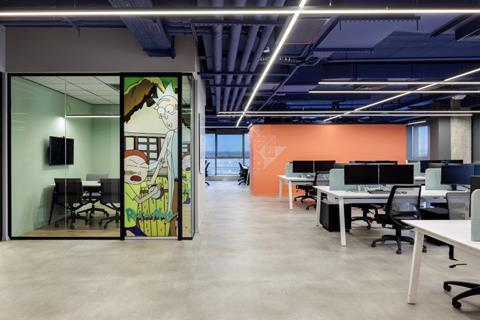The migration towards increased remote working that began before the pandemic has meant that the last 2.5 years’ impact on R&D was significantly lower than might have been expected, writes David Davies.
For any technology company, the R&D department is the motor that keeps the entire business moving forward. More often than not, it is the place where new ideas are first formulated – and then realised as end-solutions, often over a period of years. Without significant ongoing investment in R&D, most technology businesses would be hurtling head-first into their own decline.

However, in recent years, the expectations of broadcast-related R&D have moved up a gear or two. For one thing, developers have had to cope with an accelerating pace of change impacting everything from production formats to file delivery. There has also been a decisive shift away from hardware-based, on-premise solutions towards a software-centric, cloud-focused approach. Then on top of that we have had the pandemic and supply chain crises to bring an uncomfortable new feeling of uncertainty to proceedings.

But the impression from IBC 365’s conversations with six vendors strongly suggests that – if anything – R&D is thriving in response to the multiple challenges. Remote working is now well-established across the industry and is here to stay, especially among software developers. “It’s very important to get together in person on a regular basis,” said Aki Mäkivirta, R&D director of loudspeaker manufacturer Genelec. “But we are finding that [remote working] can be better when, for example, people need to be able to concentrate on more demanding tasks. You have to have good [methods of communication] in place, but once you do there is no problem in doing R&D remotely.”
Inside Broadcast R&D labs: Week-to-week cadences
Across the board, there is a general consensus that the amount of R&D being conducted remotely was already increasing markedly in the years before the pandemic. With domestic internet access now reaching a sufficient standard in many countries, many companies were advancing plans to offer employees greater flexibility in the structuring of their home and working lives. But equally, there is no doubt that the circumstances of the last few years have served to refine these processes more rapidly than might otherwise have been the case.
Read more New opportunities and new audiences on DAB+
Cameron Smith is CTO at communications and connectivity specialist Dejero, which has its primary HQ in Waterloo, Canada. “The pandemic confirmed to us that we can work effectively remote, and that it has given us more flexibility in a lot of cases,” he said, indicating that this trend compliments the firm’s long-term focus on “making our teams more nimble. We have been doing a lot with [software development practice] Agile so that our teams can undertake projects end-to-end – from initial requirements through to implementation, design and delivery.”

Realising these objectives has involved refining the allocation of work and related review processes “so that we have a good week-to-week cadence that helps with the flow of work, the onboarding of new people, and collaborating with people who are not in the same time zone.” In fact, the last-named factor has been a particular beneficiary of the new methodology: “Through working [ourselves] in different locations, I do think we have got better at working with people based in various countries.”
Like every contributor to this article, Genelec’s Mäkivirta emphasises that having standardised communications platforms across the company is a critical requirement. “We coordinate our tasks around Microsoft Teams and have found that to be a good method of working together and agreeing on things,” he said. “It’s also advantageous in that it provides a way of documenting [the R&D process] to an extent, along with tools that enable you to plan the number of tasks and allocate them to people.”
As a company closely associated with cloud-based innovation, it’s not surprising that Qwilt’s business has continued to grow throughout the pandemic era. “Business-related factors, such as our partnership with Cisco, and our ability to deploy extra services more rapidly have meant that our business has increased dramatically [in recent years]. It’s meant that we have had to expand on all fronts – including R&D,” confirmed Yoav Gressel, SVP of R&D at Qwilt.

Historically the company’s R&D activities have centred upon its primary site in Israel and a team of around 70 engineers and technology developers. Individual project development tends to be filtered into small groups working together in a close-knit way. “In the early days of the pandemic we were concerned as to whether [remote R&D would be effective], but in fact we were surprised about how well it worked,” said Gressel. “We were already using Teams for communication, and once people had their personal schedules in place as well we found that everything settled down and there was very good productivity.”
It is clear that this approach is now here to stay. “We do ask people to come in once a week on a synchronised basis with their other team members, as it helps to keep the bond between them strong. But otherwise people have the freedom to choose where they work.”
Read more IBC Technical papers 2022
R&D teams at video software developer MediaKind were already doing a lot of work remotely before Covid-19, which is perhaps just as well given the multiple industry-wide changes they have had to accommodate in recent years. “The movement from hardware to software has brought a lot of changes, and in particular we have made a big investment in microservices architecture so that we are developing software that is more platform-agnostic. It was a big change for us,” confirmed Ronan Fortune, VP media processing & delivery at MediaKind.

Simultaneously, however, the increased automation involved in some elements of R&D has lightened the burden. “We have made a major investment in QA [quality assurance] automation, which means that we are getting feedback in hours and around 70% of release test coverage is running automatically. That allows our QA teams to really focus on value-add manual testing, which has had a huge [positive] impact,” explains Fortune.
Elsewhere, “driving efficiency and automation” in its solutions is a major focus for video solutions company LTN, whose R&D philosophy emphasises a teams-based approach. Rick Young, LTN’s SVP, head of global products, commented: “We’ve embedded our R&D work throughout our development, infrastructure and products teams. We find that some of our best forward-looking development and technology decisions come from the teams that are working to solve problems and build technology on a day-to-day basis. We have folks spread out, mainly across EMEA and North America, which is a big benefit. Our teams collaborate in real time, remotely, and our portfolio of industry-leading media customers across regions gives us deeper insight into global trends.”
Inside Broadcast R&D labs: Supply chain solutions
One factor that – to a greater or lesser degree – all technology R&D departments have had to deal with since 2020 has been the supply chain crisis, beginning with semi-conductors but in time spreading to many other components required for electronics production worldwide. Compounded by worsening global instability, it’s a problem that is likely to be with us for the foreseeable future, leading many companies to review and enhance their contingency plans.

“The semi-conductor shortages have had an impact, although this has been [mitigated by] our sourcing department doing a great job and shielding us from a lot of the effects,” said Fortune.
Mäkivirta confirmed that supply chain issues have been “a continuous challenge, particularly for the ongoing products that are in regular production. So as a company Genelec has been paying a lot of attention to making sure that we always have a good supply in the warehouse to ensure we are able to deliver the product whatever the [external] challenges might be.”
For Qwilt, the experience was that “as the supply crisis kicked in, we did have to find solutions for parts that were [unavailable]. So there was work required around that as well as in certifying new types of hardware to make sure our software works perfectly on them.”
“From a hardware perspective, the global semi-conductor shortage has led us to take a number of extra steps regarding [supplier] lead times and ensuring that we are going into [supplier relationships] with a more informed decision that covers more than the technology they offer,” said Joe Hunt, SVP global R&D at Imagine Communications.
“There is a need now to think much further down the road,” adds Chris Sjerven, who is senior VP and GM of Imagine’s Networking portfolio. “If you have a lead time of, say, 12 weeks, then a quarter in you can make certain decisions. But if you now have vendors quoting 65-week lead times, for example, it does change your planning horizon a lot. You have to find additional ways of being able to get your product ready [as required] in terms of having a supply chain that can always back you up.”

Nonetheless, Imagine has been able to launch a number of new products during the pandemic, with the finessing of remote working practices – “if you are not in the same room there is going to be a lot more instant messaging than in the past” – ensuring that it keeps up with the fact that “technological development is continually accelerating,” said Hunt, adding that the pace of change is such that it’s by no means uncommon these days for a product to evolve markedly from initial design to completion: “Absolutely – that’s happened on a number of occasions, and it is something else you need to [factor in to your planning].”
Inside Broadcast R&D labs: Change is a constant
Few expect the supply chain issues to be resolved soon, and indeed there is the distinct possibility that semi-conductor availability could worsen significantly if China does take action in Taiwan. So it’s probably for the best that many companies in the M&E technology space now recognise that R&D will only need to be even more responsive in the future.
“I think change is going to a kind of constant now,” confirms Hunt. “The way of doing R&D has changed in recent years and has involved moving to working patterns that are better aligned with agility and being able to ‘steer the ship’ more effectively. I think that for us, and for others, it will continue to be a major factor. [The rate of change] is such that it has an impact on products throughout their lifecycles. For [the industry as a whole], that means there will always be a lot of issues to be worked through as technology evolves.”
Read more Supply Chain and Streaming: “Forming roadmaps for the entire industry”
























No comments yet